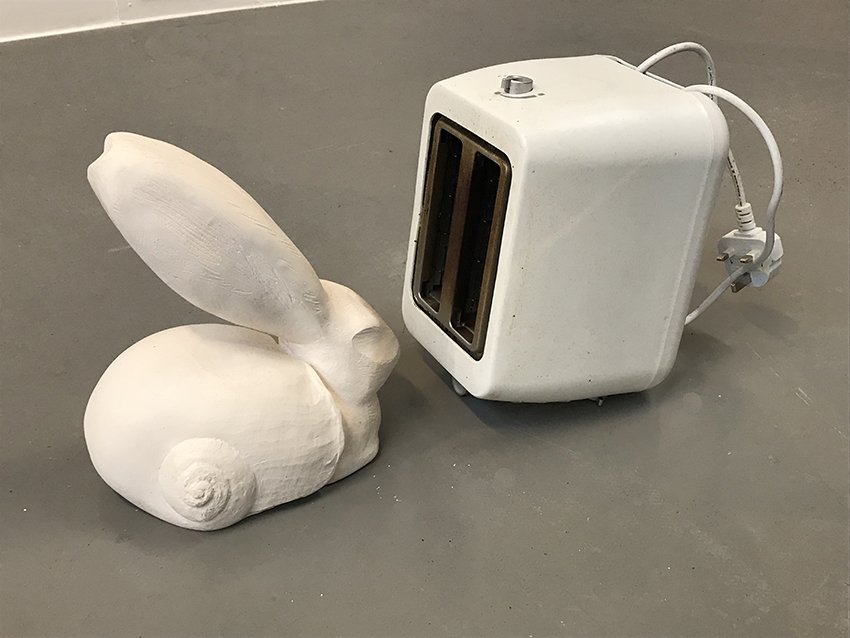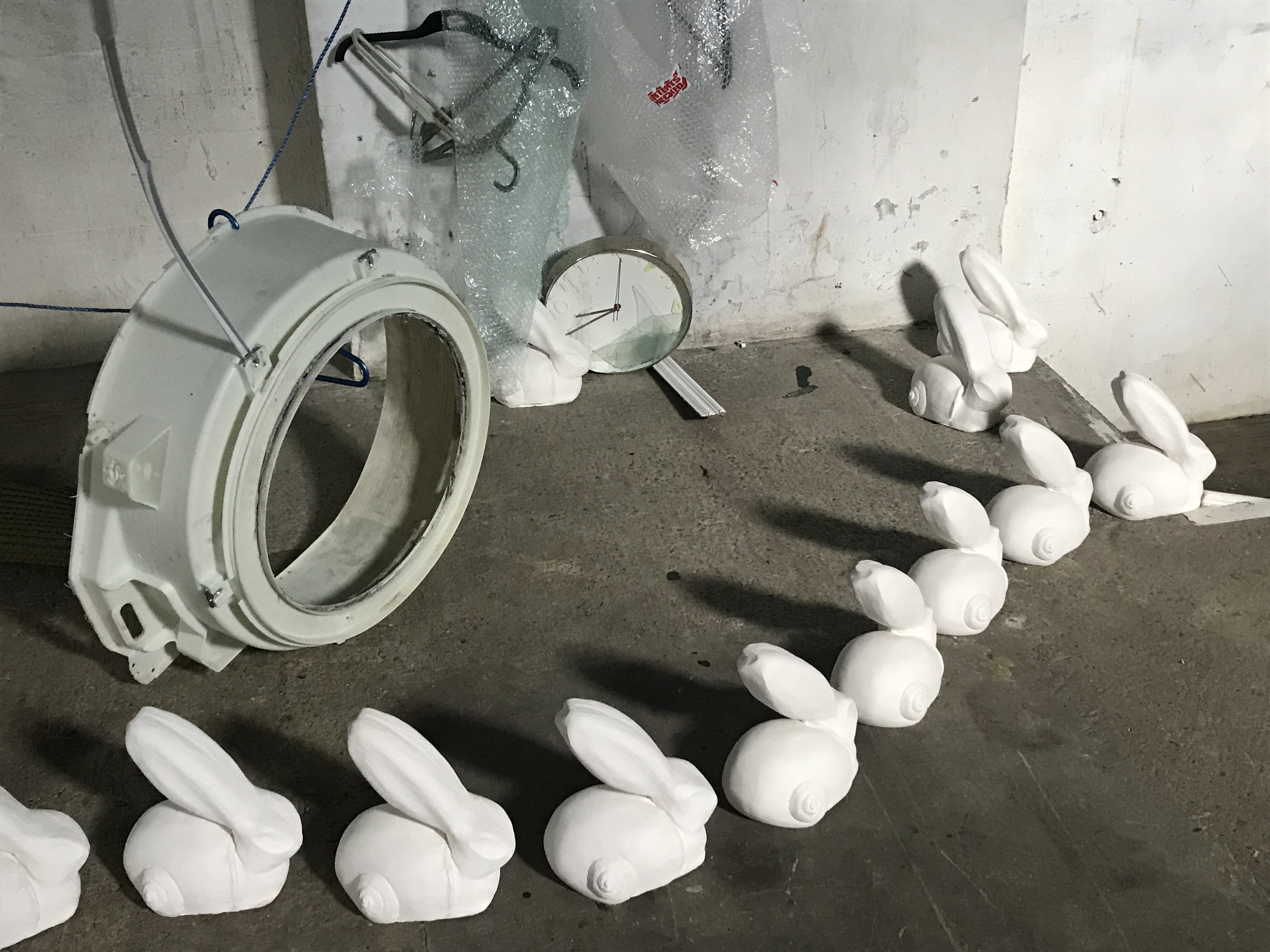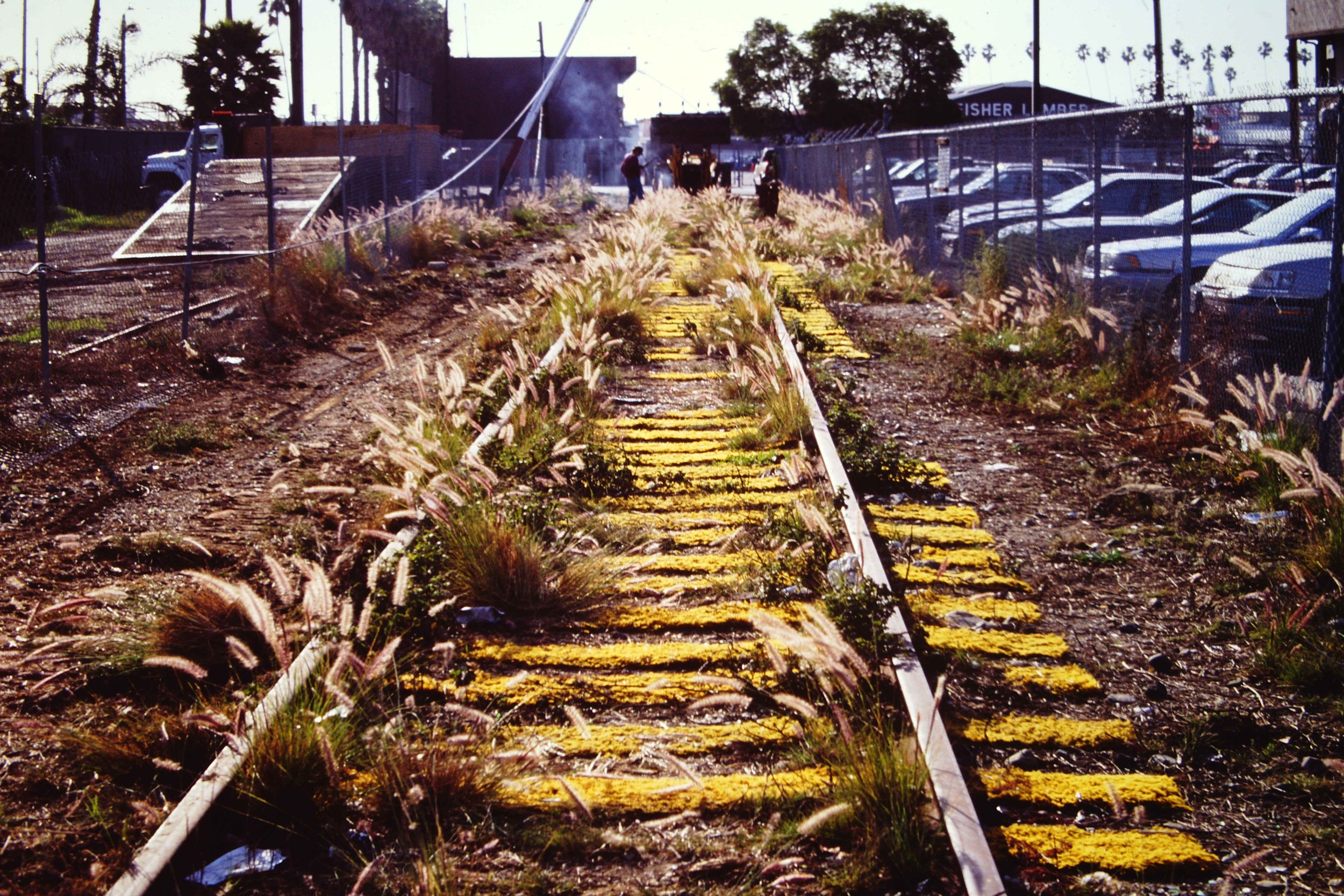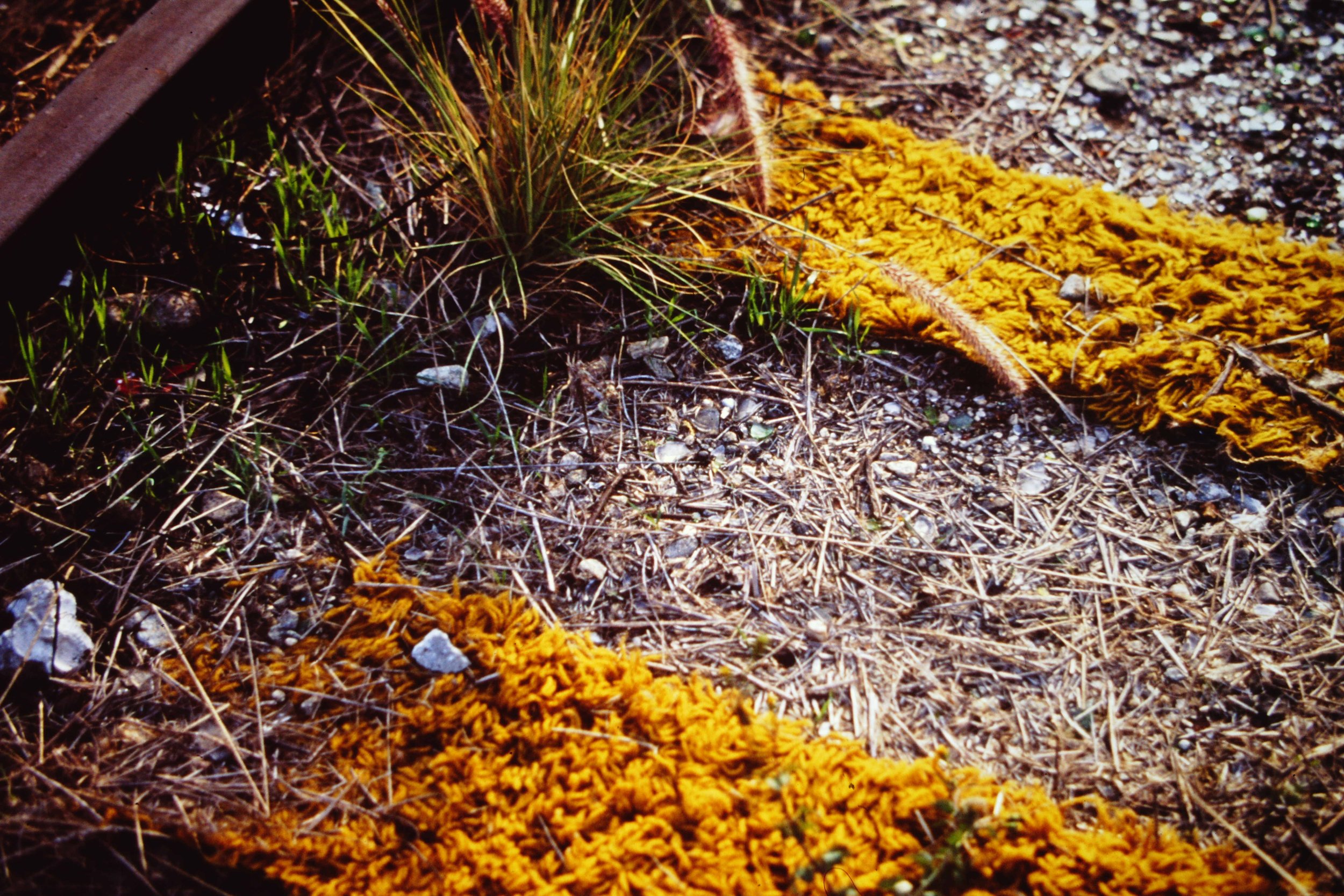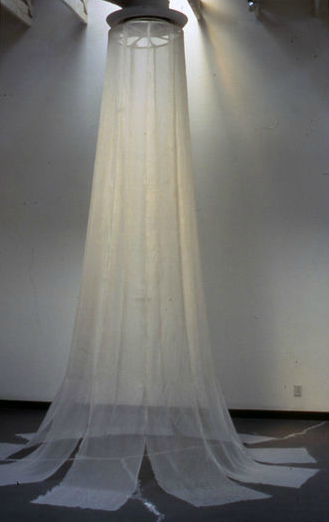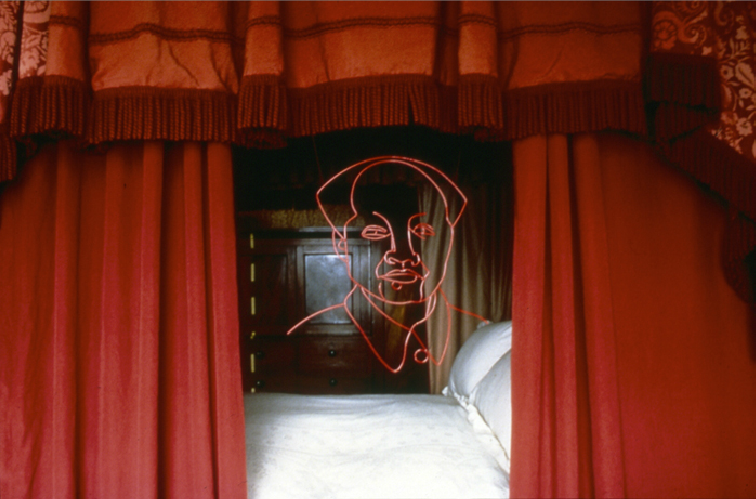WE LIVE TO BE SURPRISED, 1990 - Snabbits and Thunderbolts.
The futuristic installation, We Live to be Surprised was first exhibited in Artspace, Sydney - Bonita Ely’s Master of Art (Fine Arts) exhibition (Sydney College of the Arts, Sydney University). The snabbits hiding in apocalyptic ruins were accompanied by Thunderbolts, an installation of thunderbolts shooting up out of the floor, the Earth. A liminal zone of yellow light illuminated a passage between the two installations.
Snabbits are a genetically engineered combination of two edible creatures - the rabbit and snail - created to feed humans after the Great Monsoon destroyed all the Earth’s creatures’ habitats, leading to apocalyptic mass extinctions.
Snabbits installed in We Live to Be Surprised, a work in response to early experiments with genetic engineering, and warnings of climate change - see The Snabbit Story below..
Snabbits hiding in ruins, We live to be surprised, 1990, Artspace.
Thunderbolts, 1990, Artspace, Sydney. Exhibition, We Live to Be Surprised. Medium, stained plywood. Constructed without metal joinery.
SNABBITS - the Snabbits have been exhibited in the following events and iterations:
1989 We Live to be Surprised, “Art Dock”, Noumea, New Caledonia. Snabbit installation.
1989 We Live to be Surprised, “In Transit”, Chisenhale Gallery, London, United Kingdom. Snabbit installation.
1990 Bellas Gallery, Brisbane, The Snabbits.
2018 From the Kitchen Table: Drew Gallery Projects 1984-90, Herbert Read Gallery, University for the Creative Arts, Canterbury, UK. Snabbits.: We Live to be Surprised (2018), installation, sculpture and text works (2018).
2018 Brewery Tap Gallery, Folkestone, UK. Snabbits.: We Live to be Surprised.
2018 From the Kitchen Table: Drew Gallery Projects 1984-90, Café Gallery Projects London, Southwark Park Galleries - Dilston Gallery, London, UK. Snabbits.: We Llive to be Surprised. Installation, sculpture and text.
2019 Bonita Ely: Future Tense, Griffith University Art Museum, Brisbane. Survey exhibition.
Snabbits, Griffith University Art Museum, 2019.
Face off. Herbert Read Gallery, University for the Creative Arts, Canterbury, UK.
Camouflage. Safety in numbers.
The long march, Southwark Park Galleries - Dilston Gallery, London, UK.
WE LIVE TO BE SURPRISED - THE SNABBIT STORY
Her daughter was waiting for her. Playing between the massive remains she had climbed up the slime smoothed indentations to the top of a large dome. Rows of them formed a grid pattern along the length of the Eastern Side. Opposite were dark trenches, some filled with debris, others picked clean. Looking down they observed how the layout of the trenches reflected the tracery on the domed surfaces, looping and linking away from a central elliptical hollow.
She had planned to go to Murphey’s Beek for supplies but the roads were impassable now. This place would never have been her first choice, but it was a relief to be out of the wet. She removed her oiled wrappings, careful not to run the rip near the wing shaped part. They had been here once before. The only treasure right at the bottom, was a beautifully formed breast shaped coracle.
Building materials were needed this time as their tank had sprung leaks too disastrous to tolerate. They were very proud of their homes. Lake Women before them had built the camp on a rise overlooking the mould ponds and it had never been flooded out. The towers were built from highly prized salvage lashed securely with tubing and much ingenuity. It was impossible to approach without detection and on arrival, difficult to scale without assistance. The bastards left their stuff alone.
This security was complemented by the comfort of the tanks’ interiors. The inner quarters were cool and muted by awnings, dropped and lashed around deeply recessed eaves. A storage platform suspended below and a gantry projecting out from the roof like a prow doubled as a winch and a roost, the site of acrobatic activities during more frivolous times.
This was not frivolous. Already they were covered in slimy muck, picking their way across narrow walkways to find a place that held most promise.
Suddenly her body dropped, and with a signal for cautious advance they began slowly loosening the net slung over their shoulders.
Just ahead lay an elliptical hollow. It was quite large, measuring three body lengths wide, six lengths long. Depth was obscured by a mass of translucent creatures, opalescent in the light of haze and heat. The two exchanged quick grins, stealth uniting their movements as they converged on their prey. How easy! A readymade trap requiring only their finely woven net quietly set in place, secured them enough fresh snabbits to feed on for a long time.
When they had slaughtered and eaten their fill, the mother began to speak …
Before the Monsoon when the sun was cool and the moon could be used as a measure, when women and men spoke the same words, there were many, many different creatures inhabiting the earth. Some swam under water, some breathed air and like people, spoke their own languages – a precious gift. Other creatures walked across country and like us too, ran and hunted. Tall plants grew like water weed, out of the earth. Other creatures moved as though swimming through air, snapping up tiny winged bodies, all shapes and colours. Other creatures lived inside the earth. They dug dark, warm tunnels and many babies were born there where it was safe and soft.
Some stories tell about the sad songs they sang together on moonlit nights, their gloaming eyes and glistening bodies drawing movement lines like arterial tracks across the mosshills.
Other stories say the does laid sweet tasting brown eggs for little children like you. They brought them in baskets to each child’s bed in the night as a token of hope for their future. Other stories tell of their capture and bewail their suffering.
At first they were happy, lazy, content to be stroked and fed. But a blank depression rose in them all. At night, they pushed their bodies together in a wedge against the bleak geometry of their cells, bleached blue against contamination. Whiffs of chemicals drifted in taking possession of their senses. They were separated, cleaned, tagged, snipped. A shell house grew on their backs. Alive or dead, their silence was broken by a powerless keening and other sounds, sharp and final. They gave themselves up, forgot their smells, their bodies and each other, trapped in a mad stillness. Catatonic.
When they let them out they seemed to be able to live anywhere in their shell homes, all over the place. They were like they are now, legless, mute, each tasting more delicious and different to the other, their gristly ears good to chew. Swept along the floodwaters they survived the tornadoes of the Great Monsoon making their way into every lake and beek, to every mosshill and mouldpond. Since then they’ve become almost invisible and band together like this. Maybe a memory of the moon and the sad songs of their ancestors keep them together.
She looked down at her stained brown hands holding the blade just used to prise the shells off and slice the succulent flesh.
She stood up in the oppressive heat, flicked the net lightly back along the edge of the ellipse. A feeling of inconsolable melancholy like the unvarying mist that even the sun cannot penetrate fell over her. She arranged the net over her daughter’s shoulders, linking their transparent bodies, glistening sweat in the fading light.
……………………………………………………………………………………………………………………………………………………………………………………………………
LADY DI, 1990 - Woman as object, play thing.
The toy cardboard cutout of Lady Diana, Princess of Wales in her underwear with dress up clothes and hats were purchased in a newsagent in Sydney. She was the former consort (1981–96) of Charles, Prince of Wales (now King Charles III); the mother of William (born 1982) and Harry (born 1984); and one of the foremost celebrities of her day
Gold acrylic paint on canvas, paper cutouts, plastic hooks. Pasted on the canvas collage, top right is the Image of a snabbit = cute, easy to catch and slice, easy to breed, edible.
HISTORIES, 1992 A history of the world - wars, invasions, inventions - women are written out, no mention. The lithograph in comic book mode is included, printed by John Loane, Viridian Press. It records the time and postures of a mother and father during night feeding of their baby. Also included, an early example of QR coding with a page from a photo album, with all the missing photos dated during WW2; anatomical drawings of the male body by Andreas Vesalius (1555); diagrams of the wedge, human’s first invention (axe, triangulation, lever, spear, spearhead); a child’s drawing of a horse, its domestication dating back to the 4000BCE.
Sutton Gallery, Melbourne; Histories, Bellas Gallery, Brisbane, Queensland; Histories, Annandale Galleries, Sydney.
SLEEPERS TIES 1, 1993. Los Angeles. Australia Council Artist in residence, 18th Street Arts Complex, Santa Monica, Los Angeles, U.S.A. A site specific intervention on a remnant of LA’s public transport system. In the distance see men ripping out the railway line to extend the car park.
1993 “Sleepers/Ties 1" Urban intervention near Olympic Boulevard and 17th Street, Santa Monica, Los Angeles, California, USA.
“Sleepers/Ties 1", urban intervention - Strips of green shag pile carpet cover the sleepers (USA - ties), a remnant of LA’s public transport system.
“Sleepers/Ties 1" Urban intervention: coincidently, the next day men removed the railway line to extend the car park over the fence (ref/ Joni Mitchell’s song, Big Yellow Taxi).
SLEEPERS TIES 11, 1994
A cathartic installation in response to the 1994 earthquake in Los Angeles during Bonita Ely’s Australia Council residency at the 18th Street Arts Complex, Santa Monica.
1994 Sleepers Ties 11 – New Gallery, installation, Los Angeles, USA.
Medium: silk.
Luminescent silk forms pour down from fixtures in the gallery’s roof.
1994 Sleepers/Ties 11 detail. Medium: plaster tools caste in a salt. Tissue paper.
The tools and toys: the salt mould created a texture like fossils.
1968, installations, Elizabeth Bay House, Sydney, 1997
Program: Artists In the House. Curator: Michael Goldberg, invited artists to respond to this colonial residence, built in the mid 1830s for Colonial Secretary, Alexander Macleay. Bonita Ely inserted references to 1968 into the house, a year of multilayered historical significance. 1968 is the year before the referendum that resulted in the removal of two discriminatory clauses in Australia’s constitution: that the same laws apply to all Australians, rather than have discriminatory laws specific to Indigenous peoples; that Aboriginal people be included in the country’s census.
The Vietnam/American war was raging - see Red in the Bed in the master bedroom, a wire portrait of Mao Zedong hanging in the bed’s curtains.
In the lounge room the furniture in the colonial setting was rearranged , the seating all facing towards one direction, alluding to a television, where the recordings of 1968 news items were broadcast, for example, the assassination of Martin Luther King, anti-war protests in Australia, civil unrest in France, the Prague Spring in Czechoslovakia, which experienced freedom away from the tight communist regime of the Soviet Union.
Red in the Bed: This room is the master bedroom.
In the dining room, morning tea is served on a 1960s laminex table, where the voices of three Aboriginal Elders, Joyce Morgan, Sylvia Scott and Bronwyn Penrith, discuss their families’ histories up to 1968 and the discriminatory attitudes and laws that made their lives a misery, including the removal of children from their parents to be brought up in cruel, state run institutions.
1968 Cicadas, library. This is the position of the door leading to the library as it was in 1968. The library contains cabinets of insect specimens collected by the Macleay family. Sounds in the room combined the rising sound of cicadas with traffic noise, travelled back and forth along the length of the library.
LIGHT HOUSE, HUE, VIETNAM - 1998
His and Hers, bathroom. In 1968 the house was divided up into low rent flats, attracting artists and bohemians, including for a time the well-known artist Donald Friend. Using dotted lines throughout the house, Ely indicated where the walls of these subdivisions were in 1968. Each room addressed the momentous events of that year, set against the luxurious 1830s colonial setting.
Light House, 1998. Children’s Cultural Centre, Hue, Vietnam.
LIGHT HOUSE, 1998, Hue, Vietnam.
Made from tradition bricks from the Citadel, the form of the Light House is based on the rice grass hay stack seen around Hue’s rice paddies. After the rice harvest, rice grass was collected and stacked up around bamboo poles, and used for cooking fires. The three archway entries are children’s height. The circular base is slightly curved upwards, not flat.
It is located in the grounds of the Children’s Cultural Centre in Hue.
Light House, interior, 1998 - - looking up, the blue interior is illuminated with bands of light shining through gaps in the brickwork.
JUGGERNAUT, 1999
Mediums: plywood, gold paint around the edges, dusting of powder. The outcome of research of the cultural encoding of country in Australia, Japan, India and Europe.
Juggernaut, 1999, plywood spirals are kept in place with wedges to prevent them rolling, and spacers to keep each turn of the spirals apart & in tension.
Juggernaut was inspired by research of the inscription of animist cultures’ narratives on landscape in Australia (First Nation songlines), India (Hindu mythology) England (Stone Henge, Avebury).
Exhibitions Asian Biennale of Contemporary Art, Dhaka, Bangladesh; Solo exhibition, Customs House, Sydney; Bellas Gallery, Brisbane.
Juggernaut, 1999
Juggernaut, 1999. Spacers to keep the spirals apart, in tension. Customs House, Sydney.
Juggernaut, 1999. Each turn of the spiral’s interior shapes are an improvisation on the circle. Bellas Gallery, Brisbane.




